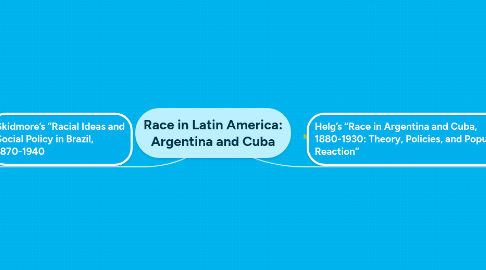
1. Skidmore’s “Racial Ideas and Social Policy in Brazil, 1870-1940
1.1. Brazil received more African slaves than other Americas' countries. Brazil has a large mixed-race intermediate category.
1.2. Brazilian thinkers worried about the past and wondered how to prepare for the future
1.3. Race was seldom discussed in this liberal agitation atmosphere, and liberals talked about slavery. The one writing that stood out was as follows: No one believed in the theory of biological inferiority, so abolitionists rarely tried to refuse racist doctrines.
1.4. Miscegenation was perceived as regenerative in ferm of culture contacts, if not biologically.
1.5. Whitening thesis was widely supported in Brazil due to the belief that Portuguese enjoyed the ability to whiten the darker people with whom they mixed.
1.5.1. Immigrants were sought to continue the whitening ideology predominant among the abolitionists. This ideology accepted the mulatto but not the black.
1.6. Brazil was slower to pick up currents from European thought than some other Latin American countries. Relative isolation was maintained also due to the fact that there were no universities.
1.7. Antiracism became a part of the nationalist thought.By 1918, an increasing number of intellectuals openly contested racist ideas. They picked their own evidence to support refutations of the racists. In addition, they were aware of the existing discrimination against blacks in the U.S.
2. Helg’s “Race in Argentina and Cuba, 1880-1930: Theory, Policies, and Popular Reaction”
2.1. In many countries, the elite was Creole and the popular classes Indian, black, mestizo, mulatto.
2.1.1. Affected by European ideas of race
2.2. Hispanic American intellectuals were inspired by racial theories emanating from Europe.
2.2.1. Positivism, social Darwinism, geographical determinism.
2.2.1.1. These ideas were embraced until 1920s when they were silenced by different movements
2.3. By the beginning of 20th century, Argentina had become European stock nation through immigration, wars, extermination of Indians
2.3.1. Cuba gained its independence in 1898
2.3.1.1. Old hope that blacks would disappear due to miscegenation and massive immigration of whites
2.4. 3 intellectuals: Sarmiento, Bunge, Ingenieros
2.4.1. Sarmiento: no doubt that Anglo-Saxon and Christian US was the incarnation of the most civilized race; inferior races could evolve in the future through education
2.4.2. Bunge: saw the ethnic composition as the most important issue of Latin America; again, Anglo-Saxons were at the top of the racial hierarchy
2.4.3. Ingenieros: stood for coherent and intransigent racial evolutionism, believed the theory of biogenetic correlation. Concluded that colored races were inferior, unable to adapt to white civilization.
2.4.4. Author concluded that darker races would vanish and only the white one would survive, and there would be variety of ethnic groups that would belong to the white race.
2.5. topics relating to blacks, Indians and miscegenation were put off and attention was redirected to immigration issues - they became unimportant minorities, and the major social issue was now immigration - Argentinian nationalism was revived.
2.5.1. Nationalist education movement began
2.6. Figures attempted to prove Cubans' racial incapacity to form a independent republic. Argued that natural selection would lead to the absorption of blacks by a superior race.
2.6.1. Ortiz integrated the criminology of Italian physician Lombroso focusing on cultural manifestations of race rather than physical. Proposed to eliminate manifestations of African culture.
